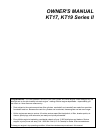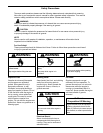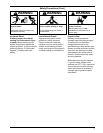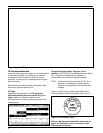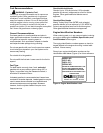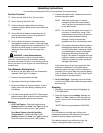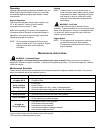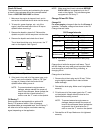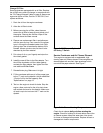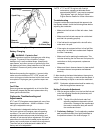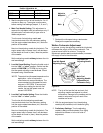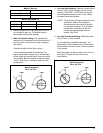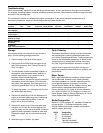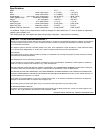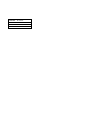
6
Operating Instructions
Also read the operating instructions of the equipment this engine powers.
Pre-Start Checklist
o Check oil level. Add oil if low. Do not overfill.
o Check fuel level. Add fuel if low.
o Check cooling air intake areas and external
surfaces of engine. Make sure they are clean and
unobstructed.
o Check that the air cleaner components and all
shrouds, equipment covers, and guards are in
place and securely fastened.
o Check that any clutches or transmissions are
disengaged or placed in neutral. This is especially
important on equipment with hydrostatic drive. The
shift lever must be exactly in neutral to prevent
resistance which could keep the engine from
starting.
WARNING: Lethal Exhaust Gases!
Engine exhaust gases contain poisonous carbon
monoxide. Carbon monoxide is odorless, colorless,
and can cause death if inhaled. Avoid inhaling exhaust
fumes, and never run the engine in a closed building or
confined area.
Cold Weather Starting Hints
1. Be sure to use the proper oil for the temperature
expected. See Figure 2 on page 4.
2. Declutch all possible external loads.
3. Set speed control at part throttle position.
4. Be sure the battery is in good condition. A warm
battery has much more starting capacity than a
cold battery.
5. Use fresh winter grade fuel. NOTE: Winter grade
gasoline has a higher volatility to improve starting.
Do not use gasoline left over from summer.
Starting
1. On a Cold Engine Place the throttle control
midway between the "slow" and "fast" positions.
Place the choke control into the "on" position.
On a Warm Engine (Normal Operating
Temperatures) Place the throttle control
midway between the "slow" and "fast" positions.
Place the choke control into the "off" position.
2. Activate the starter switch. Release the switch as
soon as the engine starts.
NOTE: After starting the engine, it may be
necessary to leave the choke partially
"on" for a few minutes before moving it
to the "off" position.
NOTE: Do not crank the engine continuously for
more than 10 seconds at a time. If the
engine does not start, allow a 60 second
cool down period between starting
attempts. Failure to follow these
guidelines can burn out the starter motor.
NOTE: If the engine develops sufficient speed to
disengage the starter but does not keep
running (a false start), the engine rotation
must be allowed to come to a complete
stop before attempting to restart the
engine. If the starter is engaged while the
flywheel is rotating, the starter pinion and
flywheel ring gear may clash, resulting in
damage to the starter.
If the starter does not turn the engine over, shut
off starter immediately. Do not make further
attempts to start the engine until the condition is
corrected. Do not jump start using another battery
(refer to Battery below). See your Kohler Engine
Service Dealer for trouble analysis.
3. On a Cold Engine Gradually return the choke
control to the "off" position after the engine starts
and warms up.
Stopping
1. If possible, remove the load by disengaging all
PTO attachments.
2. Place the throttle control midway* between the
"stop" and "fast" positions. Allow the engine to
run for a minimum of 15 seconds; then stop the
engine.
*NOTE: Minimum engine speed of 2400 RPM.
Battery
A 12 volt battery is normally used. Refer to the
operating instructions of the equipment this engine
powers for specific battery requirements.
If the battery charge is not sufficient to crank the
engine, recharge the battery (see page 11).



